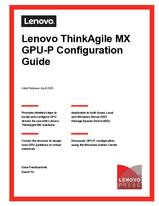Authors
Published
9 Apr 2025Form Number
LP2197PDF size
18 pages, 812 KBAbstract
Graphics Processing Unit (GPU) virtualization technologies enable GPU acceleration in a virtualized environment, typically within virtual machines. If a workload is virtualized with Hyper-V, graphics virtualization can be employed in order to provide GPU acceleration from the physical GPU to the virtualized apps or services. GPUs can be included in an Azure Local instance to provide GPU acceleration to workloads running in clustered virtual machines.
This document provides instructions and examples to configure GPU-P for use by an Azure Local instance or S2D cluster in Windows Server 2025 Datacenter Edition. We assume that the cluster has already been created. We include information for installing GPU device drivers on hosts and VMs, creating GPU partitions, assigning these partitions to VMs, and configuring Windows Admin Center to view and manage GPU partitions.
Table of Contents
Introduction
GPU driver installation
Create and assign GPU partitions
Manage GPUs using WAC
Summary
Additional resources
To view the document, click the Download PDF button.
Configure and Buy
Full Change History
Course Detail
Employees Only Content
The content in this document with a is only visible to employees who are logged in. Logon using your Lenovo ITcode and password via Lenovo single-signon (SSO).
The author of the document has determined that this content is classified as Lenovo Internal and should not be normally be made available to people who are not employees or contractors. This includes partners, customers, and competitors. The reasons may vary and you should reach out to the authors of the document for clarification, if needed. Be cautious about sharing this content with others as it may contain sensitive information.
Any visitor to the Lenovo Press web site who is not logged on will not be able to see this employee-only content. This content is excluded from search engine indexes and will not appear in any search results.
For all users, including logged-in employees, this employee-only content does not appear in the PDF version of this document.
This functionality is cookie based. The web site will normally remember your login state between browser sessions, however, if you clear cookies at the end of a session or work in an Incognito/Private browser window, then you will need to log in each time.
If you have any questions about this feature of the Lenovo Press web, please email David Watts at dwatts@lenovo.com.

